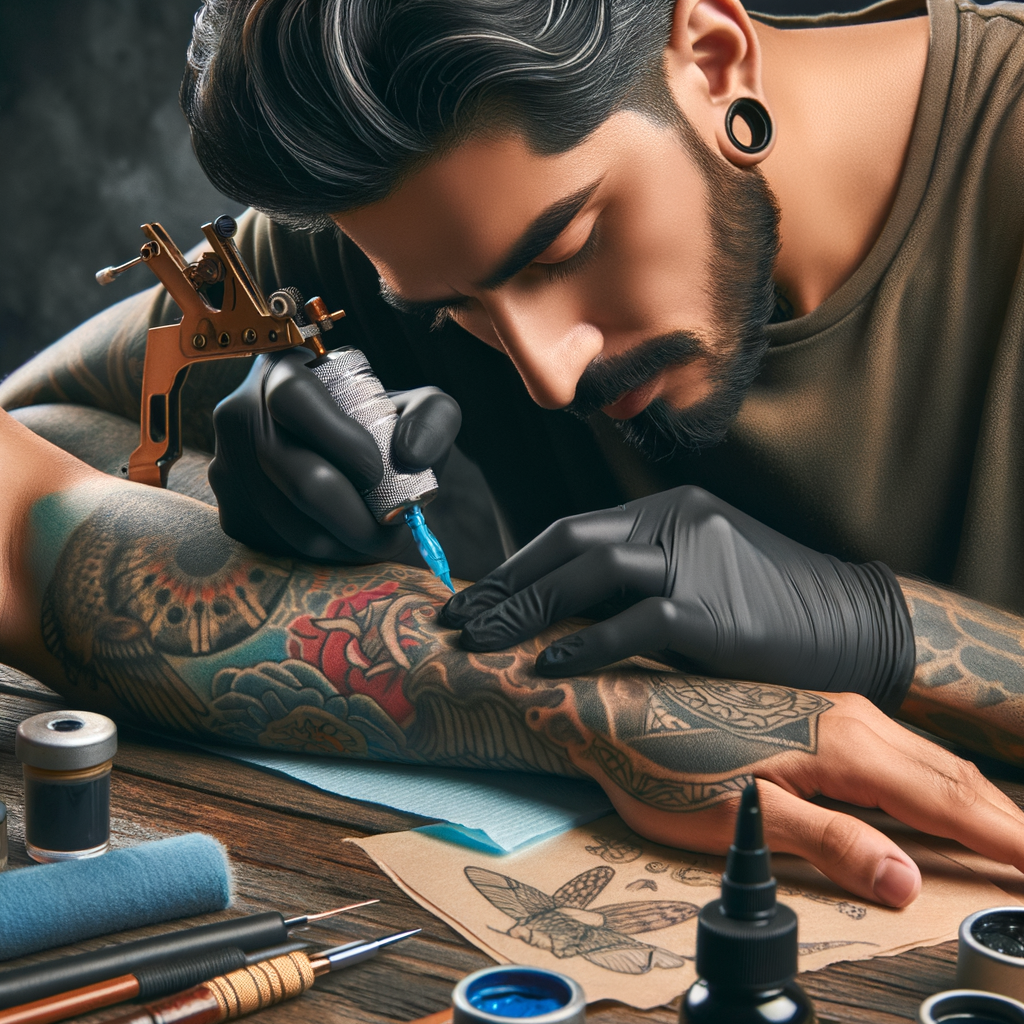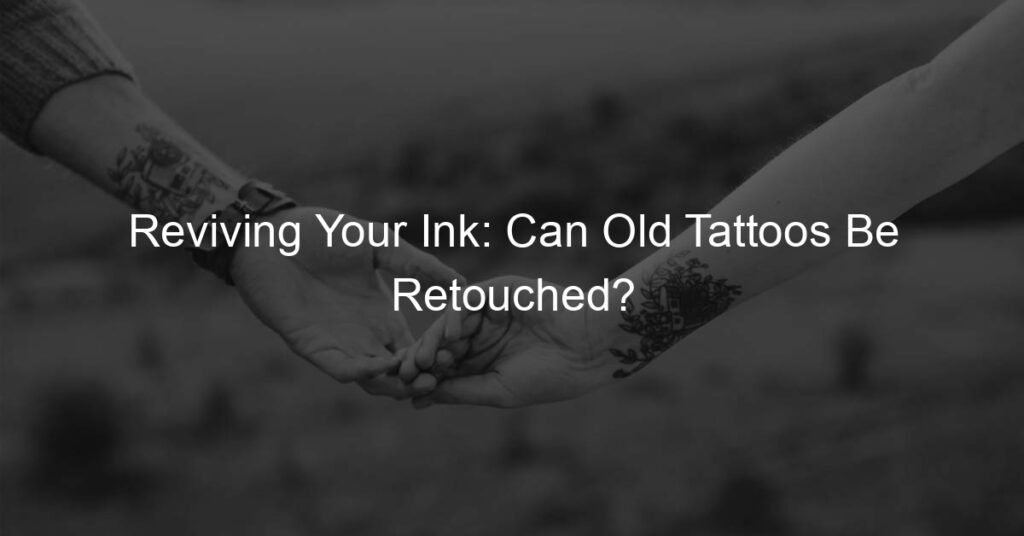
Introduction to Tattoo Preservation
When we think about tattoos, we often focus on the design, the colors, and the meaning behind the ink. However, an equally important aspect is the preservation of these beautiful pieces of body art. In this blog post, we will delve into the importance of tattoo preservation and provide an overview of the tattoo aging process.
-
- Understanding the Importance of Tattoo Art Preservation
Tattoos are more than just ink on skin – they are a form of self-expression, a way to commemorate significant events or people, and for some, a work of art. Preserving the vibrancy and clarity of these tattoos is crucial to maintaining their beauty and significance. Tattoo preservation is not just about keeping the colors bright, but also about maintaining the health of your skin. Proper care can prevent infections, scarring, and other skin issues that can distort or fade your tattoo.
-
- Overview of the Tattoo Aging Process
Just like our skin, tattoos age over time. The ink begins to spread out under the skin, causing the design to blur. Sun exposure, skin type, and the quality of the ink and equipment used can also affect how a tattoo ages. For example, tattoos exposed to the sun without protection can fade faster. Understanding this process is the first step towards effective tattoo preservation.
In the following sections, we will explore the nuances of understanding old tattoos, reviving them, and maintaining them. We will also delve into the art of tattoo preservation in the conclusion. Stay tuned to learn more about this fascinating topic!
Understanding Old Tattoos
When we think about tattoos, we often imagine them as permanent marks on our skin. However, like everything else, tattoos too age and change over time. Let’s delve into understanding what happens to tattoos as they get older.
What Happens to Tattoos Over Time?
Over time, tattoos undergo significant changes. These changes are influenced by various factors, including changes in our skin and our lifestyle. Let’s explore these factors in more detail.
-
- How skin changes affect tattoos
As we age, our skin changes. It loses its elasticity and becomes thinner. This can cause tattoos to fade and lose their original sharpness. For instance, a study found that 50% of tattoos on people over 40 had faded significantly. This is because the ink particles in the tattoo break down over time, and the body’s natural aging process accelerates this.
-
- How lifestyle factors can influence tattoo aging
Lifestyle factors also play a crucial role in how a tattoo ages. Sun exposure, for example, can cause tattoos to fade faster. Similarly, habits like smoking can affect the skin’s health and, in turn, the appearance of a tattoo. A survey found that smokers were more likely to report dissatisfaction with their tattoos over time.
In conclusion, understanding how tattoos age can help us make informed decisions about getting inked and taking care of our tattoos. It’s important to remember that while tattoos are a form of self-expression, they also require maintenance and care to keep them looking their best.
Common Issues with Old Tattoos
As tattoos age, they may encounter a few common problems. These issues can affect the overall appearance and vibrancy of your tattoo. Let’s delve into two of the most prevalent issues that old tattoos face.
-
- Fading of Color
One of the most common issues with old tattoos is the fading of color. Over time, the vibrant hues that were once a part of your tattoo may start to look dull and less vibrant. This fading can be attributed to various factors such as exposure to sunlight, the quality of the ink used, and the depth at which the ink was injected into the skin.
According to a study, about 50% of tattoos start to fade within 10 to 15 years. This fading can be more pronounced in tattoos that have been exposed to excessive sunlight. The UV rays from the sun can break down the tattoo ink, causing it to fade faster.
-
- Blurring of Lines and Details
Another common issue with old tattoos is the blurring of lines and details. This happens when the ink spreads out under the skin over time. This process, known as “tattoo blowout,” can cause the lines of your tattoo to appear less sharp and the details to become less clear.
Blurring can also be caused by the natural aging process of the skin. As we age, our skin loses its elasticity and becomes thinner. This can cause the tattoo ink to spread out and blur the lines and details of the tattoo.
In conclusion, while tattoos are a permanent form of body art, they are not immune to the effects of time and environmental factors. Understanding these common issues can help you take the necessary steps to preserve the vibrancy and clarity of your tattoos for as long as possible.
Reviving Old Tattoos
As time passes, tattoos can fade, lose their sharpness, or simply not look as vibrant as they once did. But don’t worry, there’s a solution to this. Let’s explore the fascinating world of reviving old tattoos.
Can Old Tattoos Be Retouched?
Many people wonder if their old tattoos can be given a new lease of life. The answer is a resounding yes! Old tattoos can indeed be retouched, and the results can be quite impressive.
-
- Exploring the possibility of retouching old tattoos
Retouching is a process where a tattoo artist goes over an existing tattoo with new ink, to bring back its original vibrancy and detail. This process can breathe new life into the tattoo, making it look as good as new. It’s like giving your tattoo a fresh coat of paint. The process requires a skilled tattoo artist who can match the original colors and understand the original design.
-
- Case study: Successful tattoo restoration
Let’s look at a real-life example of successful tattoo restoration. John, a 45-year-old man, had a tattoo on his arm that he got when he was just 18. Over the years, the tattoo had faded and lost its sharpness. John decided to get his tattoo retouched. The tattoo artist carefully went over the old design, adding fresh ink and sharpening the details. After the process, John’s tattoo looked vibrant and sharp, just like it did when he first got it. This case study shows that with the right skills and techniques, old tattoos can be successfully restored.
So, if you have an old tattoo that’s looking a bit worn and faded, don’t despair. With the right tattoo artist and the right techniques, your old tattoo can be revived and look as good as new.
Tattoo Retouch Techniques
When it comes to reviving old tattoos, there are several techniques that can be used. These methods help to bring back the vibrancy and detail that may have faded over time. Let’s explore these techniques in more detail.
-
- Color Enhancement
Color enhancement is a technique used to make the colors in your tattoo pop again. Over time, the colors in a tattoo can fade due to exposure to sunlight, skin shedding, and other factors. By using special inks and techniques, a tattoo artist can bring those colors back to life. It’s like giving your tattoo a fresh coat of paint!
-
- Detail Sharpening
Detail sharpening is another technique that can be used to revive an old tattoo. This involves going over the lines and details of the tattoo to make them more defined. It’s a bit like tracing over a drawing with a fine-tipped pen to make the lines stand out more. This technique can be particularly useful for tattoos with intricate designs or lots of small details.
-
- Complete Tattoo Redo
Finally, in some cases, a complete tattoo redo might be the best option. This involves tattooing over the entire old tattoo to create a new design. It’s a big step and not one to be taken lightly, but it can be a great way to give an old tattoo a new lease on life. It’s like getting a brand new tattoo, but with the added bonus of covering up an old one that you’re not happy with.
Remember, the best method for you will depend on the condition of your tattoo and what you want to achieve. It’s always a good idea to consult with a professional tattoo artist to discuss your options.
Tattoo Maintenance
Keeping your tattoo vibrant and fresh is a task that requires consistent care. One of the key aspects of tattoo maintenance is preserving its color. Let’s delve into the details of how to achieve this.
Preserving Tattoo Color
Preserving the color of your tattoo involves two crucial steps: using sunscreen and moisturizing regularly. These steps are essential in ensuring that your tattoo remains as vibrant as the day you got it.
- Importance of SunscreenDirect sunlight can fade the color of your tattoo. Ultraviolet (UV) rays break down the pigment in your tattoo, causing it to fade over time. That’s why applying sunscreen is so important. It’s recommended to use a sunscreen with at least SPF 30. This will protect your tattoo from harmful UV rays and keep the colors vibrant. Remember, even on cloudy days, UV rays can still reach your skin, so make sure to apply sunscreen regularly.
- Role of Moisturizing in Color PreservationMoisturizing is another crucial step in preserving the color of your tattoo. Dry skin can make your tattoo look dull and faded. Regularly applying a quality moisturizer can help maintain the vibrancy of your tattoo’s colors. It keeps your skin hydrated and healthy, which in turn keeps your tattoo looking its best. It’s recommended to moisturize your tattoo at least once a day, especially during dry seasons.
In conclusion, preserving the color of your tattoo involves consistent care and attention. By using sunscreen and moisturizing regularly, you can ensure that your tattoo remains vibrant and fresh for years to come.
Old Tattoo Care
Just like a classic car or a timeless piece of art, your old tattoos need proper care to maintain their beauty. Here are two essential steps to keep your old tattoos looking vibrant and fresh.
- Regular Skin Exfoliation
Exfoliation is the process of removing dead skin cells from the surface of your skin. This is an important step in old tattoo care because it helps to reveal the ink that’s been covered by layers of dead skin, making your tattoo look brighter and more vibrant. You can exfoliate your skin using a gentle scrub or an exfoliating glove. Remember, the key is to be gentle to avoid damaging your skin and the tattoo.
- Proper Hydration and Nutrition
Keeping your skin hydrated and nourished is another crucial step in old tattoo care. When your skin is well-hydrated, it looks healthier and more vibrant, which can help your old tattoos stand out. Drinking plenty of water and using a good moisturizer can help keep your skin hydrated. Additionally, eating a balanced diet rich in vitamins and minerals can help nourish your skin from the inside out. This not only improves the appearance of your skin but also helps in maintaining the vibrancy of your tattoos.
In conclusion, taking care of your old tattoos involves regular skin exfoliation and maintaining proper hydration and nutrition. By following these steps, you can ensure that your tattoos continue to look as good as the day you got them.
Conclusion: The Art of Tattoo Preservation
As we reach the end of our journey into the world of tattoo preservation, it’s clear that this art form is more than just skin deep. It’s about expressing oneself, preserving memories, and maintaining a piece of personal history. But like any other form of art, it requires care and attention to keep it looking its best.
-
- Key takeaways on reviving old tattoos
Reviving old tattoos is a delicate process that requires a skilled hand. The first step is to consult with a professional tattoo artist who can assess the condition of your tattoo and recommend the best course of action. This may involve touch-ups to restore faded colors, or a cover-up design if the original tattoo is beyond repair. Remember, patience is key in this process as it may take multiple sessions to achieve the desired result.
-
- Final thoughts on tattoo maintenance and care
Tattoo maintenance is an ongoing commitment. It starts with proper aftercare immediately following the tattoo session, which includes keeping the area clean and moisturized, and avoiding sun exposure. Over time, regular moisturizing and sun protection can help keep your tattoo vibrant. If you notice any changes in your tattoo, such as fading or discoloration, it’s best to consult with a professional.
In conclusion, tattoos are a beautiful way to express oneself and tell a story. But like any good story, they need to be preserved and cared for to keep them alive. With the right knowledge and care, you can ensure that your tattoo remains a vibrant and meaningful part of you for many years to come.
| Tattoo Care Tips | Description |
|---|---|
| Aftercare | Keep the tattooed area clean and moisturized, and avoid sun exposure. |
| Maintenance | Regularly moisturize your tattoo and protect it from the sun to keep it vibrant. |
| Revival | If your tattoo fades or discolors, consult with a professional for possible touch-ups or cover-ups. |






